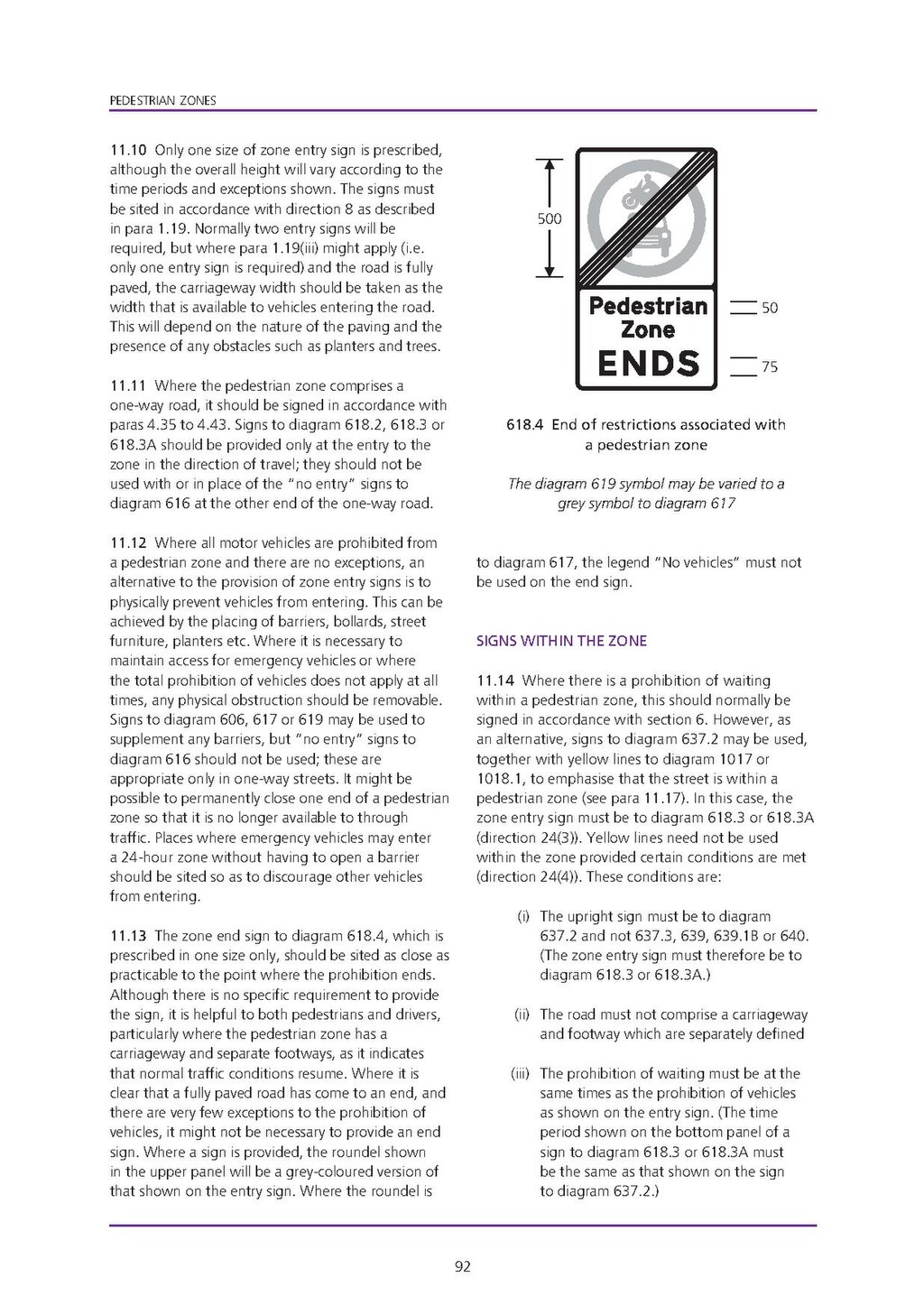11.10 Only one size of zone entry sign is prescribed, although the overall height will vary according to the time periods and exceptions shown. The signs must be sited in accordance with direction 8 as described in para 1.19. Normally two entry signs will be required, but where para 1.19(iii) might apply (i.e. only one entry sign is required) and the road is fully paved, the carriageway width should be taken as the width that is available to vehicles entering the road. This will depend on the nature of the paving and the presence of any obstacles such as planters and trees.
11.11 Where the pedestrian zone comprises a one—way road, it should be signed in accordance with paras 4.35 to 4.43. Signs to diagram 618.2, 618.3 or 618.3A should be provided only at the entry to the zone in the direction of travel; they should not be used with or in place of the "no entry" signs to diagram 616 at the other end of the one-way road.
11.12 Where all motor vehicles are prohibited from a pedestrian zone and there are no exceptions, an alternative to the provision of zone entry signs is to physically prevent vehicles from entering. This can be achieved by the placing of barriers, bollards, street furniture, planters etc. Where it is necessary to maintain access for emergency vehicles or where the total prohibition of vehicles does not apply at all times, any physical obstruction should be removable. Signs to diagram 606, 617 or 619 may be used to supplement any barriers, but "no entry" signs to diagram 616 should not be used; these are appropriate only in one—way streets. It might be possible to permanently close one end of a pedestrian zone so that it is no longer available to through traffic. Places where emergency vehicles may enter a 24-hour zone without having to open a barrier should be sited so as to discourage other vehicles from entering.

618.4 End of restrictions associated with a pedestrian zone
The diagram 619 symbol may be varied to a grey symbol to diagram 617
11.13 The zone end sign to diagram 618.4, which is prescribed in one size only, should be sited as close as practicable to the point where the prohibition ends. Although there is no specific requirement to provide the sign, it is helpful to both pedestrians and drivers, particularly where the pedestrian zone has a carriageway and separate footways, as it indicates that normal traffic conditions resume. Where it is clear that a fully paved road has come to an end, and there are very few exceptions to the prohibition of vehicles, it might not be necessary to provide an end sign. Where a sign is provided, the roundel shown in the upper panel will be a grey—coloured version of that shown on the entry sign. Where the roundel is to diagram 617, the legend "No vehicles" must not be used on the end sign.
SIGNS WITHIN THE ZONE
11.14 Where there is a prohibition of waiting within a pedestrian zone, this should normally be signed in accordance with section 6. However, as an alternative, signs to diagram 637.2 may be used, together with yellow lines to diagram 1017 or 1018.1, to emphasise that the street is within a pedestrian zone (see para 11.17). In this case, the zone entry sign must be to diagram 618.3 or 618.3A (direction 24(3)). Yellow lines need not be used within the zone provided certain conditions are met (direction 24(4)). These conditions are:
(i) The upright sign must be to diagram 637.2 and not 637.3, 639, 639.1B or 640. (The zone entry sign must therefore be to diagram 618.3 or 618.3A.)
(ii) The road must not comprise a carriageway and footway which are separately defined
(iii) The prohibition of waiting must be at the same times as the prohibition of vehicles as shown on the entry sign. (The time period shown on the bottom panel of a sign to diagram 618.3 or 618.3A must be the same as that shown on the sign to diagram 637.2.)
92
